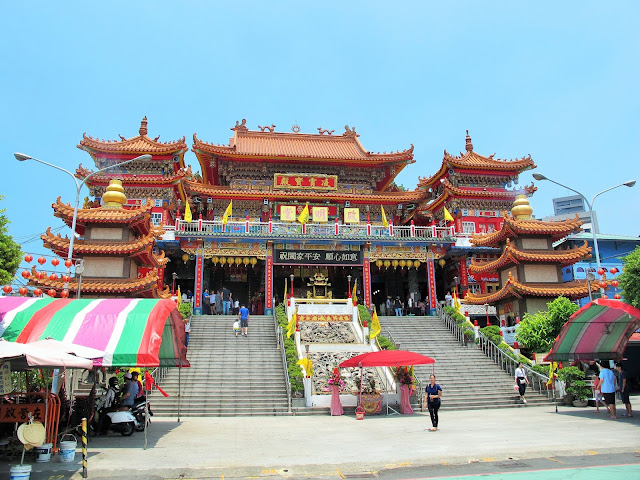 |
| The Image of Our Lady of the Most Holy Rosary being brought our of the church for a procession |
October 7 is the Feast of
Our Lady of the Holy Rosary. In late afternoon of that day, the city of San
Pablo in Laguna, which is known for its seven lakes, held a solemn procession,
starting at the eighteenth-century Saint Paul the First Hermit Cathedral. The
city though celebrates its feast day on January 15, honoring Saint Paul the First Hermit, its patron saint
after which it is named.
The procession, participated in mostly by students of
San Pablo's schools, was spearheaded by Don Conrado "Ado" Escudero,
owner of the Villa Escudero, a sprawling hacienda that has plantations,
a popular resort and recently real-estate developments. His sister, Consuelo,
served as hermana mayor. The Escuderos are devout Catholics. Their
family museum, which is a popular destination inside the plantation resort,
houses numerous old images of saints and the Virgin. An impressive statue of
Our Lady of the Most Holy Rosary inside San Pablo church is originally owned by
Don Ado's mother, Rosario Adap Escudero.
"My mother left us an image, which is something
to behold. Not only it is beautiful, it is precious because it is made of
silver, gold and ivory. It is something we can be proud of," Don Ado
related. "Years and years ago, the original image of Our Lady of the Holy
Rosary was brought to Manila from San Pablo. The image was brought out every
year, every October, so they requested my mother to have one made so that they
could continue the tradition, because, you known, San Pablo is one of the
oldest mission churches in the country. Nowadays, the young generation's
preoccupation is not really embdded with religious instruction. And we want to
continue (the tradition)."
He then asked the bishop if they can continue the
tradition of celebrating the Feast of Our Lady of the Holy Rosary, and the
response was enthusiastic. He was told though that the people, especially the
younger people, might not be interested, but Don Ado did not mind and persuaded
them to let him do what he wanted to do. The image, after some time, again was
brought out of the church last year.
"It was a successful event," he said. Thus,
he did it again this year, calling the procession as "peace rally,"
responding to the current time of uncertainty and violence.
The eighty-six-year-old Don Ado is known for keeping
old traditions, and Villa Escudero is the crowning glory of his efforts, where
visitors are afforded an old hacienda way of living and enjoying.
The hacienda is about a thousand hectares, Don
Ado said, and it traverses the city of San Pablo and the town of Tiaong in
Quezon. It was founded in the 1880s by Don Placido Escudero and his wife Dona
Claudia Marasigan, originally planted with sugar cane. Their son Don Arsenio
Escudero turned to coconuts in the early 1900s. He is said to be an agro-industrialist,
who built the country's first working hydroelectric plant, which is now an
attraction at the hacienda. His children, including Don Ado, opened the hacienda
to the public in 1981.
Villa Escudero Plantations and Resort is known for
its carabao-drawn carriages that bring visitors around. The structures reflect
traditional architecture designs and used native materials. The food, overseen
by its current executive chef Cocoy Ventura, is Filipino. One can feast on a
buffet by the dam, behind the hydroelectric plant, where the water cascades
from a reservoire and flows through your feet while you eat. This feasting on
the stream and by the waterfall has become a signature Villa Escudero
experience. There are also regular performances of Filipino folk songs and
dances.
Villa Escudero is an iconic destination of Laguna and
Quezon, said Rebecca V. Labit, regional director of the Department of Tourism.
And about 800 people visits it every day.
Indeed, that Saturday the hacienda-resort buzzed with visitors, families
enjoying the weekend, bakadas on excursions and Filipinos bringing their
foreigner guests to experience an idyllic Filipino setting.  |
| Our Lady of the Most Holy Rosary of San Pablo, originally owned by the Escuderos |

































